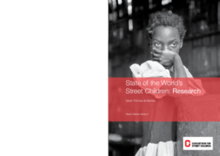This State of the World’s Street Children: Research report presents a unique Literature Review of international research studies about street children published during the decade from 2000 to 2010. Studies have been collected and ‘mapped’ into 12 thematic sections, drawing on more than 400 papers, chapters and books published around the world in the English language. Studies consulted were primarily academic, supplemented with key texts from the development literature on street children. Gaps between and within thematic sections have been identified and analyzed.
The report’s dual purpose is:
-
to improve understanding of street children by identifying recent advances in an academic scholarship which began in the 1970s
-
to identify priority areas for academic research on street children, in order to build a stronger strategic base for the development of advocacy, policy and programme design initiatives.
This report divides into four parts and a total of 12 sections, which reflect the most interesting advances in the academic research over the last 10 years:
1. Understanding Street Children: Old Myths and New Realities Numbers, Definitions, Characteristics and Voices from the Streets
2. Street Children and Everyday Lives – The Wider Picture Relationships, Migration and Mobility, Experiences on the Streets and Ageing into Youth
3. Policies and Interventions for Street Children
4. Street Children’s Rights, Laws, Budgets and Funding.
The report’s findings are summarised at the end of each part and drawn together here in the form of 12 key findings: Four Research Advances, Four Research Gaps and Four Points for Advocacy:
Top Four Advances in Street Children Research
-
Street children are recognized to be young people who experience a combination of multiple deprivations and ‘street-connectedness’. This combination requires a specific focus on street children within wider policy agendas and interventions, to restore access to their legal human rights.
- Street children’s everyday experiences and relationships are recognised to be at least as important as numbers and characteristics, for understanding their lives and designing appropriate policies, programmes and models of care.
- Street children should participate, as standard practice, as informants and co-researchers in research about themselves. Their circumstances and experiences imply special ethical dilemmas for research strategies and techniques.
-
Longitudinal, repeat and comparative studies are recognized as vital for developing our understanding of street children’s careers within society, for assessing policy and programme impacts and for designing preventive strategies.
Top Four Gaps in Street Children Research
-
Academic and development studies are conducted and used in isolation from each other. This means that academic advances rarely inform development practice and vice versa.
-
Academic understanding about street children is fragmented into small islands of research within separate disciplines. This means research in law, economics or public policy on street children rarely informs or is informed by sociological, anthropological or geographical research.
-
Research into street children is not systemic, so street children’s experiences are disassociated from the laws, policies, interventions and environments that affect them. Research must explore links between children’s environments and strive to understand their interconnected nature.
-
No motor exists for building a body of research on street children – a collective entity is needed to drive forward concerted knowledge development within academia and development practice to improve prevention and inclusion.
Top Four Findings for Advocacy
-
Street children must be distinguished – but not isolated – from other children in policy frameworks and intervention design, to respond to the nature of their multiple deprivations and to their street-connectedness.
-
Transparency of information about budget allocations, child protection systems and evaluation of their impacts on children is needed to identify missing links between laws, policies, interventions and children’s realities and at preventive level for effective protection of rights.
-
Local level policies and interventions involving NGOs and local authorities must be supported by effective national laws and budgets to prevent and protect street children successfully.
-
Investment in research is needed to develop and consolidate a strategic knowledge base capable of informing laws, policies and interventions to respond to street-connected children and youth and to protect young people from multiple deprivations.

